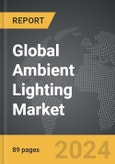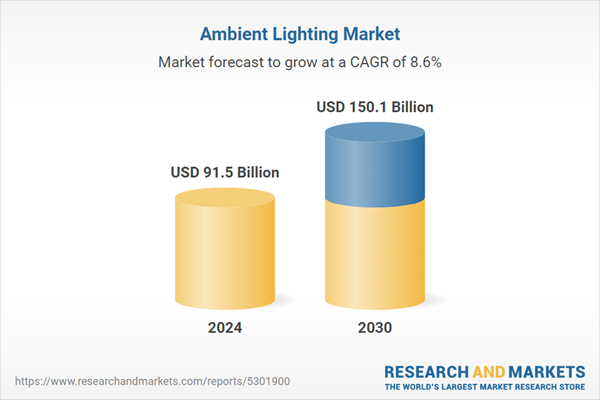The global market for Ambient Lighting was valued at US$91.5 Billion in 2024 and is projected to reach US$150.1 Billion by 2030, growing at a CAGR of 8.6% from 2024 to 2030. This comprehensive report provides an in-depth analysis of market trends, drivers, and forecasts, helping you make informed business decisions. The report includes the most recent global tariff developments and how they impact the Ambient Lighting market.
Segments: Component (Hardware, Software & Services); Type (Recessed Lights, Surface-Mounted Lights, Suspended Lights, Track Lights, Strip Lights); End-Use (Residential, Hospitality & Retail, Healthcare, Automotive, Office Buildings, Industrial).
Geographic Regions/Countries: World; United States; Canada; Japan; China; Europe (France; Germany; Italy; United Kingdom; Spain; Russia; and Rest of Europe); Asia-Pacific (Australia; India; South Korea; and Rest of Asia-Pacific); Latin America (Argentina; Brazil; Mexico; and Rest of Latin America); Middle East (Iran; Israel; Saudi Arabia; United Arab Emirates; and Rest of Middle East); and Africa.
The analysts continuously track trade developments worldwide, drawing insights from leading global economists and over 200 industry and policy institutions, including think tanks, trade organizations, and national economic advisory bodies. This intelligence is integrated into forecasting models to provide timely, data-driven analysis of emerging risks and opportunities.
Global Ambient Lighting Market - Key Trends and Drivers Summarized
Why Has Ambient Lighting Become Essential in Interior Design?
Ambient lighting has rapidly emerged as a cornerstone of modern interior design, revolutionizing how spaces are experienced. Unlike traditional task or accent lighting, ambient lighting creates a soft, diffused glow that fills the room, eliminating harsh shadows and enhancing the overall atmosphere. Its role in setting the mood is unparalleled, as it creates a calm, welcoming environment, making any space feel more comfortable and inviting. This type of lighting is now essential in both residential and commercial settings, from cozy living rooms to sophisticated offices, restaurants, and retail spaces. Beyond aesthetics, ambient lighting is also highly functional, providing even illumination that supports daily activities without overwhelming the eyes. As home automation systems and smart lighting technology become more prevalent, ambient lighting has further evolved, offering adjustable color temperatures and brightness levels that allow users to personalize their space based on the time of day or activity. The integration of LED technology has significantly contributed to its growth, making it energy-efficient and customizable, enabling homeowners and businesses to create energy-conscious, beautiful environments that align with their functional and emotional needs.What Makes Ambient Lighting a Game-Changer in Commercial and Public Spaces?
The rise of ambient lighting in commercial and public spaces can be attributed to its ability to transform large, impersonal environments into comfortable, human-centered spaces. In retail stores, for example, ambient lighting helps to create an inviting atmosphere that encourages shoppers to explore and stay longer, directly influencing purchasing behavior. Studies have shown that well-designed lighting can positively impact customer moods and perceptions, making ambient lighting a critical component in the design of shopping centers, boutiques, and malls. In corporate environments, ambient lighting plays a significant role in fostering productivity and well-being. By reducing the strain on employees' eyes and creating a balanced light environment, ambient lighting helps maintain focus and comfort during long working hours. Hospitals and healthcare settings also benefit from ambient lighting, where it can reduce stress and anxiety for patients, contributing to faster recovery times and a more pleasant experience overall. Airports, hotels, and restaurants use ambient lighting to enhance the user experience, ensuring that travelers, diners, and guests feel relaxed and comfortable. In these high-traffic environments, ambient lighting is more than just a design choice - it's a strategic tool that supports the goals of creating efficient, soothing spaces that cater to the emotional and physical needs of their users.How Are Technology and Consumer Preferences Shaping the Ambient Lighting Market?
Technological advancements and shifting consumer preferences are fundamentally reshaping the ambient lighting market. The development of smart lighting systems has allowed users to control their lighting environments with unprecedented precision. Through mobile apps or voice-controlled devices, people can now adjust the color temperature, brightness, and even the hues of their ambient lighting to suit different moods or activities. This personalization has made ambient lighting not only more functional but also a key element in home automation. Furthermore, the growing demand for sustainable living has led to widespread adoption of energy-efficient LED lighting for ambient purposes. LEDs consume significantly less energy compared to traditional incandescent bulbs, and they have a longer lifespan, which reduces both energy costs and the need for frequent replacements. This environmental consciousness has extended into commercial and industrial spaces, where businesses are increasingly adopting LED ambient lighting to meet regulatory standards and corporate sustainability goals. Consumers are also seeking lighting solutions that align with minimalist and clean design trends, which has resulted in a growing preference for unobtrusive lighting fixtures, recessed lights, and integrated lighting systems that offer seamless illumination without drawing attention to the source. In combination, these trends point to a future where ambient lighting is not only more accessible and customizable but also more efficient and aligned with modern design philosophies.What Are the Factors Driving the Growth in the Ambient Lighting Market?
The growth in the ambient lighting market is driven by several factors that span technological advancements, consumer behavior shifts, and broader market dynamics. First, the rise of smart home technology has been a major driver, as more homeowners are incorporating connected lighting systems that allow them to control their environment with ease. The ability to automate lighting based on schedules, occupancy, or even weather conditions has significantly increased the appeal of ambient lighting, making it a staple in modern homes. In the commercial sector, businesses are increasingly adopting ambient lighting for its ability to improve employee productivity and customer satisfaction. As companies recognize the link between well-designed lighting and workplace efficiency, investments in ambient lighting solutions have surged. Moreover, the global trend toward sustainability is propelling the market forward, as LED lighting solutions - which are the primary choice for ambient lighting - are far more energy-efficient and eco-friendly than traditional lighting options. This is particularly important in regions with stringent energy regulations and incentives for green building certifications. The rapid urbanization in emerging economies is also fueling demand, with new residential and commercial buildings prioritizing energy-efficient and aesthetically pleasing lighting designs. Lastly, as architectural trends continue to favor open-plan living and working spaces, ambient lighting has become essential in creating cohesive, harmonious environments that feel spacious yet comfortable. All these factors are converging to drive significant growth in the ambient lighting market, making it a key focus area for innovation and development in the coming years.Report Scope
The report analyzes the Ambient Lighting market, presented in terms of units. The analysis covers the key segments and geographic regions outlined below.Segments: Component (Hardware, Software & Services); Type (Recessed Lights, Surface-Mounted Lights, Suspended Lights, Track Lights, Strip Lights); End-Use (Residential, Hospitality & Retail, Healthcare, Automotive, Office Buildings, Industrial).
Geographic Regions/Countries: World; United States; Canada; Japan; China; Europe (France; Germany; Italy; United Kingdom; Spain; Russia; and Rest of Europe); Asia-Pacific (Australia; India; South Korea; and Rest of Asia-Pacific); Latin America (Argentina; Brazil; Mexico; and Rest of Latin America); Middle East (Iran; Israel; Saudi Arabia; United Arab Emirates; and Rest of Middle East); and Africa.
Key Insights:
- Market Growth: Understand the significant growth trajectory of the Hardware segment, which is expected to reach US$93.5 Billion by 2030 with a CAGR of a 8.6%. The Software & Services segment is also set to grow at 8.5% CAGR over the analysis period.
- Regional Analysis: Gain insights into the U.S. market, valued at $23.7 Billion in 2024, and China, forecasted to grow at an impressive 12.5% CAGR to reach $37.3 Billion by 2030. Discover growth trends in other key regions, including Japan, Canada, Germany, and the Asia-Pacific.
Why You Should Buy This Report:
- Detailed Market Analysis: Access a thorough analysis of the Global Ambient Lighting Market, covering all major geographic regions and market segments.
- Competitive Insights: Get an overview of the competitive landscape, including the market presence of major players across different geographies.
- Future Trends and Drivers: Understand the key trends and drivers shaping the future of the Global Ambient Lighting Market.
- Actionable Insights: Benefit from actionable insights that can help you identify new revenue opportunities and make strategic business decisions.
Key Questions Answered:
- How is the Global Ambient Lighting Market expected to evolve by 2030?
- What are the main drivers and restraints affecting the market?
- Which market segments will grow the most over the forecast period?
- How will market shares for different regions and segments change by 2030?
- Who are the leading players in the market, and what are their prospects?
Report Features:
- Comprehensive Market Data: Independent analysis of annual sales and market forecasts in US$ Million from 2024 to 2030.
- In-Depth Regional Analysis: Detailed insights into key markets, including the U.S., China, Japan, Canada, Europe, Asia-Pacific, Latin America, Middle East, and Africa.
- Company Profiles: Coverage of players such as Acuity Brands, Inc., General Electric Company, Hafele, Honeywell International Inc., Hubbell Incorporated and more.
- Complimentary Updates: Receive free report updates for one year to keep you informed of the latest market developments.
Some of the 33 companies featured in this Ambient Lighting market report include:
- Acuity Brands, Inc.
- General Electric Company
- Hafele
- Honeywell International Inc.
- Hubbell Incorporated
- Ideal Industries, Inc. (Cree Lighting)
- Lutron Electronics Co., Inc.
- Osram Licht Ag
- Signify N.V.
- Zumtobel Group Ag
Tariff Impact Analysis: Key Insights for 2025
Global tariff negotiations across 180+ countries are reshaping supply chains, costs, and competitiveness. This report reflects the latest developments as of April 2025 and incorporates forward-looking insights into the market outlook.The analysts continuously track trade developments worldwide, drawing insights from leading global economists and over 200 industry and policy institutions, including think tanks, trade organizations, and national economic advisory bodies. This intelligence is integrated into forecasting models to provide timely, data-driven analysis of emerging risks and opportunities.
What’s Included in This Edition:
- Tariff-adjusted market forecasts by region and segment
- Analysis of cost and supply chain implications by sourcing and trade exposure
- Strategic insights into geographic shifts
Buyers receive a free July 2025 update with:
- Finalized tariff impacts and new trade agreement effects
- Updated projections reflecting global sourcing and cost shifts
- Expanded country-specific coverage across the industry
Table of Contents
I. METHODOLOGYII. EXECUTIVE SUMMARY2. FOCUS ON SELECT PLAYERSIII. MARKET ANALYSISCANADAITALYSPAINRUSSIAREST OF EUROPESOUTH KOREAREST OF ASIA-PACIFICARGENTINABRAZILMEXICOREST OF LATIN AMERICAIRANISRAELSAUDI ARABIAUNITED ARAB EMIRATESREST OF MIDDLE EASTIV. COMPETITION
1. MARKET OVERVIEW
3. MARKET TRENDS & DRIVERS
4. GLOBAL MARKET PERSPECTIVE
UNITED STATES
JAPAN
CHINA
EUROPE
FRANCE
GERMANY
UNITED KINGDOM
ASIA-PACIFIC
AUSTRALIA
INDIA
LATIN AMERICA
MIDDLE EAST
AFRICA
Companies Mentioned (Partial List)
A selection of companies mentioned in this report includes, but is not limited to:
- Acuity Brands, Inc.
- General Electric Company
- Hafele
- Honeywell International Inc.
- Hubbell Incorporated
- Ideal Industries, Inc. (Cree Lighting)
- Lutron Electronics Co., Inc.
- Osram Licht Ag
- Signify N.V.
- Zumtobel Group Ag
Table Information
| Report Attribute | Details |
|---|---|
| No. of Pages | 89 |
| Published | April 2025 |
| Forecast Period | 2024 - 2030 |
| Estimated Market Value ( USD | $ 91.5 Billion |
| Forecasted Market Value ( USD | $ 150.1 Billion |
| Compound Annual Growth Rate | 8.6% |
| Regions Covered | Global |









